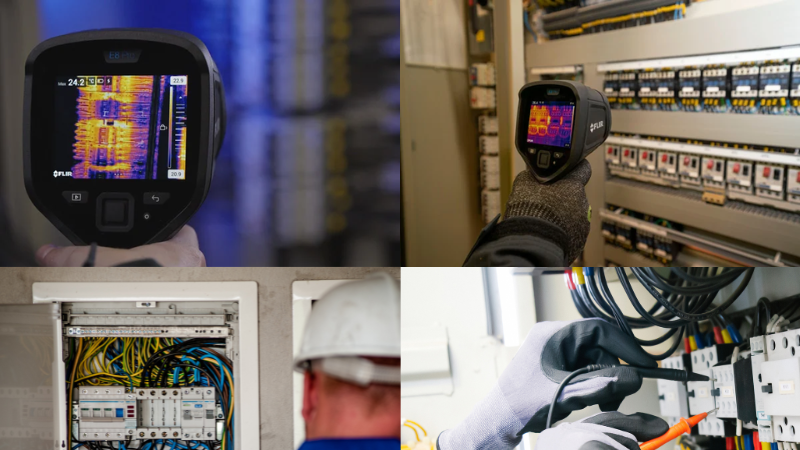Your Cart is Empty
📱GOT QUESTIONS? GIVE US A CALL ON +61 8 7083 9862📱
📱GOT QUESTIONS? GIVE US A CALL ON +61 8 7083 9862📱
INDUSTRY
ABOUT US
Thermal Electrical Inspections Australia - A Comprehensive Guide
by Curtis Treloar February 20, 2024 4 min read

Thermal Electrical Inspections Australia - A Comprehensive Guide
- Introduction Thermal Electrical Inspections
- Understanding Thermal Imaging in Electrical Inspections
- Certification Standards in Australia
- Electrical Code of Practice
- Equipment Standards
- Conducting a Thermal Electrical Inspection
- Why Choose Thermal Imaging?
- Common Requirements for Thermal Imaging Inspections in Australia
Introduction Thermal Electrical Inspections
In the world of electrical safety and maintenance, Thermal Cameras play a crucial role. This article aims to provide a detailed insight into thermal electrical inspections, especially focusing on the Australian context. Note: This article is for informational purposes and should not be used as a substitute for legal advice.

Understanding Thermal Imaging in Electrical Inspections
What is Thermal Imaging?
Thermal imaging, a non-destructive testing method, uses infrared cameras to detect temperature variations. These variations often indicate potential electrical issues like overheating, which can lead to equipment failure or fire hazards.
Importance in Australia
In Australia, thermal imaging is increasingly recognised for its ability to prevent electrical fires by identifying hot spots in electrical systems. This method has become integral in the electrical industry for predictive maintenance and identifying potential safety hazards.
Certification Standards in Australia
Certification Categories
Australian standards, particularly AS ISO 18436.7:2014, outline certification categories for professionals conducting thermographic inspections:
- Category I: Basic fault detection, operation of thermal imaging equipment, and basic image post-processing.
- Category II: Advanced fault diagnoses, selection of appropriate thermography techniques, and report preparation on equipment condition.
Training and Experience Requirements
- Category I: Minimum 32 hours of classroom training and 12 months of practical experience.
- Category II: Minimum 64 hours of classroom training and 24 months of experience.
Electrical Code of Practice
Overview
Australia and New Zealand have developed an electrical code of practice for thermal imaging due to the absence of specific Australian standards in this area. This code references electrical regulations, safety requirements, and standard practices for thermal inspection.
Key Aspects of the Code
- Criteria for thermographer qualifications.
- Adoption of best practices and industry uniformity.
Equipment Standards
Minimum Camera Specifications
Insurance reporting and client requirements often stipulate the use of thermal cameras with a minimum pixel count of 320 x 240. However, specifications may vary based on individual client requirements.
Conducting a Thermal Electrical Inspection
Process Overview
- Inspection Using Infrared Camera: The camera detects heat emitted from electrical components, highlighting areas with abnormal temperatures.
- Analysis and Reporting: Qualified thermographers analyse the thermal images to identify potential issues and provide detailed reports.
Frequency of Inspections
Regular inspections are recommended to ensure safety and compliance. The frequency can vary based on the scale and complexity of the electrical infrastructure.

Why Choose Thermal Imaging?
- Preventive Maintenance: Early detection of potential faults.
- Cost Efficiency: Minimizes downtime and maintenance costs.
- Safety Compliance: Assists in meeting insurance and workplace health and safety requirements.
Common Requirements for Thermal Imaging Inspections in Australia
There are typical requirements that are commonly adhered to. However, it's important to remember that these can vary depending on the specific needs of each client.
Level 1 Thermal Imaging Accreditation Most often, a Level 1 thermal imaging accreditation is considered sufficient for conducting basic thermal imaging tasks. This level of accreditation ensures that the thermographer has foundational knowledge and skills in thermal imaging techniques, equipment operation, basic fault detection, and assessment.
Thermal Camera Specifications A key equipment requirement is the thermal camera's resolution. Generally, a thermal camera with a minimum pixel count of 320 x 240 is used. This resolution is considered adequate for a range of applications, providing sufficient detail for effective thermal analysis in many standard inspection scenarios.
Client-Specific Requirements It's crucial to note that these requirements can change based on the specific demands of different clients/Insurers. Some clients/Insurers may require higher levels of accreditation or more advanced equipment specifications based on the complexity or critical nature of the tasks at hand.
Always tailor your approach to meet the specific requirements set out by your client & insurance provider, and if in doubt, consult with them to ensure compliance with their standards and expectations.
This section is particularly important for those in the industry to understand and adhere to, as meeting these common requirements can significantly impact the quality and reliability of thermal imaging services provided.
Conclusion
Thermal electrical inspections are a critical aspect of electrical safety and maintenance. While standards and practices vary, the importance of using qualified professionals and appropriate equipment remains constant. For specific legal requirements and guidelines, it's advisable to seek independent legal advice.
Advanced Tools
Click here to browse our Thermal Imaging solutions. Alternatively, give us a call on 1300 525 120 and we will tailor a camera to suit your needs.
| SHOP THERMAL CAMERAS |
Disclaimer
While the Australian Standards mentioned in this article are not legally mandated, compliance with them is often a requirement in various insurance policies, service or construction contracts. These documents typically state that all work should align with the relevant Australian Standards. Not adhering to these standards could mean breaching the terms of insurance policies or other agreements. It's advisable to consult with your insurance representative & legal practitioner, if you have any uncertainties regarding compliance with these standards.
Advanced Tools is indemnified from any liability, loss, or damage arising from the use of or reliance on this information, and users are advised to consult their insurance representatives and legal practitioners for any concerns regarding compliance with Australian Standards, Regulations or legislation.
